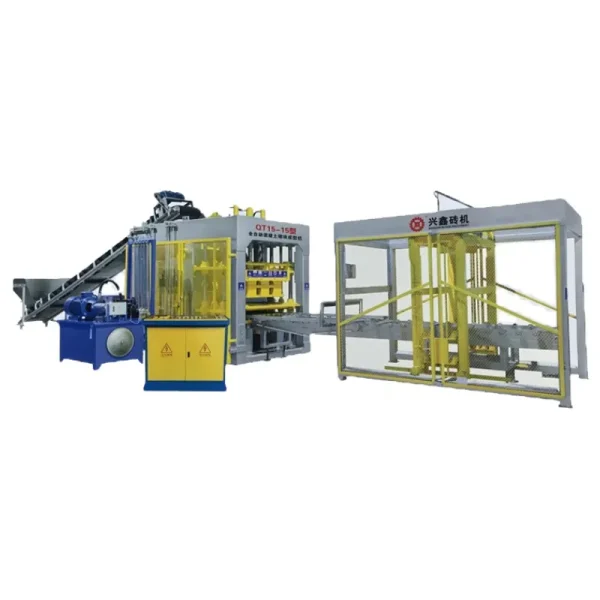2025年にROIを最大化するブロック生産に不可欠な7つの補助システム
8月 28, 2025
要旨
ブロック製造について総合的に検討すると、中心となるブロック製造機械は極めて重要ではあるが、作業を成功させるための一要素に過ぎないことがわかる。真の効率性、安定した品質、収益性の最大化は、ブロック製造のための統合された補助システム一式にかかっている。この分析では、単体の機械を高性能な生産ラインに変えるために不可欠な7つの補助システムについて掘り下げます。材料の精度を確保するコンクリートバッチプラント(#39)の役割、連続的なワークフローを維持するパレット循環システム(#39)の機能、デリケートな未硬化製品を処理するブロックコンベヤとスタッカー(#39)の重要性を調査します。さらに、様々な硬化システムを調査し、特に東南アジアと中東の気候的背景の中で、最終的なブロックの強度と耐久性に与える影響を解明する。さらに、キュービング/パッケージング・システム、先進的なPLC制御センター、高品質の金型がもたらす多用途性についても考察する。ブロック生産のためのこれらの補助システムの相乗的な統合は、操作上の贅沢品としてではなく、競争の激しい2025年の建設資材市場で規模、信頼性、優れた投資収益率を達成することを目指す真剣な企業にとって基本的に必要なものとして提示されている。
要点
- ブロック生産用の補助システム一式を統合し、最高の効率を実現する。
- 安定したブロック品質を保証するため、精密コンクリートバッチプラントを優先する。
- パレットとブロックのハンドリングを自動化し、人件費と製品損傷を削減します。
- ブロックの強度を最大にするために、気候に適した硬化システムを選択する。
- 合理化された操作とリアルタイムの診断のためにPLC制御システムを利用します。
- 製品の均一性と汎用性を確保するために、高品質で耐久性のある金型に投資する。
- 生産ラインを単なる中央の機械ではなく、一つの統合されたシステムとして捉える。
目次
- 基礎の重要性なぜ補助システムはオプションではないのか
- 1.コンクリートバッチプラント材料一貫性の核心
- 2.パレット供給と循環システム:オートメーションの隠れたヒーロー
- 3.ブロックコンベヤーとスタッカーグリーンブロックに優しいハンドリング
- 4.硬化システム:強度と耐久性の坩堝
- 5.キュービングとパッケージングシステムプロフェッショナリズムの最後の仕上げ
- 6.コントロールシステムオペレーションの頭脳
- 7.金型システム多様性の設計者
- 相乗的な生産ラインのためのシステム統合
- よくある質問(FAQ)
- 結論
- 参考文献

基礎の重要性なぜ補助システムはオプションではないのか
コンクリート・ブロック製造の分野で確固たる存在感を示そうとすると、奇妙な、そしてしばしばコストのかかる固定観念が生じることがある。実業家志望の人々の関心は、パワフルでリズミカルな作業の心臓部である主要なブロック製造機械に完全に奪われてしまうことがよくある。その力強さに魅了されるのは簡単なことだ。 静油圧ブロックプレス機 あるいは、全自動コンクリートブロック製造機QTシリーズの自動バレエ。とはいえ、この装置ひとつだけに注目するのは、弦楽器、打楽器、木管楽器、そしてそれらを調和させる指揮者の深い貢献を無視して、リード・ヴァイオリンだけでオーケストラを判断するようなものだ。ブロックマシンは、そのパワーはともかく、真空の中でその任務を遂行することはできない。サポート・ネットワークが必要であり、ブロック製造のための綿密に設計された一連の補助システム、つまり、ブロック製造の準備、運搬、養生、梱包が必要なのだ。これらのシステムをおろそかにすることは、コスト削減策ではなく、非効率、一貫性のない製品品質、そして投資収益率の大幅な低下への直接の道である。
コアマシンを超える
コンクリート・ブロックの旅は、原材料が型に入るずっと前から始まり、ブロックがプレスされたずっと後に終わる。セメント、骨材、水の正確な計量と混合から始まる。パレットのシームレスな搬入、成型されたばかりの「グリーン」ブロックの穏やかな運搬、強度を増す重要な養生期間、そして最終的な積み上げと梱包による配送へと続きます。これらの各段階は、補助システムによって管理されている。これらの段階のどれかひとつに不具合や非効率が生じると、中央の機械がいかに強力であろうと、生産ライン全体を機能不全に陥らせるボトルネックが発生する。世界一流のスプリンターが、柔らかい砂のトラックを走ることを余儀なくされるのを想像してみてほしい。彼らの個人的能力は計り知れないが、そのパフォーマンスは周囲のシステムの不備によって左右される。同様に、適切に混合されたコンクリートに飢えたり、遅い手作業による積み重ねプロセスで窒息したりした大容量のブロック機械は、その潜在能力のほんの一部で働く資産である。生産設備の能力を測る真の指標は、プレス機の理論上の生産量ではなく、統合されたライン全体の実際の生産量である。
類推:オーケストラと指揮者
このコンセプトを真に理解するために、オーケストラに話を戻そう。ブロックマシンは、息をのむような偉業を成し遂げる名人芸を披露するソリストである。コンクリート・プラントは弦楽器セクション全体であり、メロディーの土台となる豊かで一貫性のある基礎的な素材を提供する。もし弦楽器の調子が悪ければ(不適切な混合)、演奏全体が台無しになる。パレットフィーダーとブロックコンベヤーは打楽器セクションであり、作業全体のテンポとリズムを設定し、安定した途切れることのない流れを確保する。養生システムはコンサートホールそのものであり、その音響特性(養生環境)は、音楽(ブロックの強度)が最終的にどのように展開し、知覚されるかを決定する。キューバーとパッケージング・システムは舞台係であり、最終製品がプロフェッショナルな形で提示され、聴衆への旅路のために保護されることを保証する。最後に、PLC制御システムは指揮者であり、すべてのコンポーネントを監督し、それらが完璧に同期して動作することを保証し、リアルタイムで調整を行い、アンサンブル全体を完璧なパフォーマンスへと導きます。これらの連携がなければ ブロック製造補助システム才能はあるがバラバラな音楽家が集まって、音楽ではなくノイズを生み出しているのだ。
1.コンクリートバッチプラント材料一貫性の核心
コンクリート製造における最も基本的な真実は、最終製品の品質が最初のミックスの品質に不可逆的に結びついているということである。どんなに圧力をかけても、振動を与えても、高度な養生を行っても、配合が不十分なコンクリートバッチを補うことはできません。そこで、コンクリートバッチプラントがブロック製造の補助システムの中で最も重要な役割を果たします。バッチプラントは作業全体の心臓部であり、生命線である完璧に安定したコンクリートをブロック機械に送り込みます。その機能は、超人的な精度で何度もレシピを実行し、手動または半自動ミキシング方式を悩ませる人的エラーやばらつきを排除することです。極端な気候が材料特性に影響を及ぼす可能性のある東南アジアや中東の厳しい市場でのビジネスにとって、自動バッチプラントの譲れない精度は、品質に対する評判を確立するための最初で最も重要なステップです。
化学量論的精度の原理
コンクリート・バッチプラントはその核心において、応用化学と応用物理学の訓練である。コンクリートの硬化は水和として知られる化学反応であり、セメント系材料が水と結合を形成し、骨材を結合させる結晶性マトリックスを作り出す。コンクリートブロックの強度、耐久性、さらには最終的な色は、セメント、水、砂、砂利(骨材)の正確な比率に直接左右される。水が多すぎると多孔質で弱いブロックになり、少なすぎると反応が不完全で作業性が悪くなる。
自動化されたバッチプラントは、当て推量を確実なものに変えます。高度なロードセルとデジタルスケールを使用して、あらかじめプログラムされた混合設計に従って、各構成材料をキログラム単位で計量します。これにより、ブロック・マシンに供給されるすべてのバッチが、前のバッチと同じ特性を持つことが保証されます。このレベルの一貫性は、オペレーターの疲労や数え間違い、材料の密度のばらつきの影響を受けやすい、ショベル・ロードを数えたり、容積箱を使用したりするような手作業では実現できません。
最新のバッチプラントの構造
設計は様々ですが、フルブロック生産ラインの重要なコンポーネントである典型的な自動コンクリートバッチプラントは、協調して動作するいくつかのコアコンポーネントで構成されています。これらの部品を理解することは、システム'の価値を理解するのに役立ちます。
| コンポーネント | 機能 | ブロック生産への影響 |
|---|---|---|
| 骨材収納箱 | 砂、10mmの砂利、20mmの砂利など、別々の骨材を入れる。 | 最終ブロックの密度と強度を最適化するため、異なるサイズの骨材を正確にブレンドできる。 |
| 計量ホッパー | ビンの下に設置され、ロードセルを使って骨材、セメント、水を計量する。 | これが精度の核心である。混合設計がすべてのバッチで正確に行われることを保証し、ばらつきをなくします。 |
| コンベアシステム | 計量された骨材をミキサーに運ぶ。スキップホイストまたはベルトコンベヤ。 | ベルトコンベヤは、よりスムーズで連続的な流れを提供し、大容量の輸送に理想的です。 QTシリーズ全自動コンクリートブロック製造機. |
| セメントサイロ&スクリューコンベア | バルクセメントを貯蔵し、セメント計量ホッパーに輸送する。 | セメントを湿気から保護し(予備水和)、自動化された正確な分注を可能にする。 |
| 水と混和剤システム | メーターやポンプを使用して、水や化学混和剤を計量・添加する。 | 水とセメントの比率をコントロールし、性能を向上させる化学物質(可塑剤など)を導入するのに重要。 |
| 双軸強制ミキサー | 全成分を均質なコンクリートミックスに強力かつ迅速に混合。 | 骨材のすべての粒子がセメントペーストでコーティングされ、優れた強度と均一な仕上がりを実現。 |
貧弱なミキシングがもたらす経済的・構造的影響
適切なバッチングプラントを導入しなかった場合の結果は深刻である。ミックスが一定でないため、圧縮強度の基準を満たさないブロックが高い割合で不合格となる。これは単なる無駄ではなく、利益の損失、原材料の浪費、エネルギーの浪費となる。さらに、品質にばらつきのあるブロックを生産する企業は、請負業者やエンジニアからの信頼をすぐに失うことになる。建設基準が厳しくなるのは当然のことである地域では、信頼性が低いという評判は命取りになりかねない。規格外のブロックが原因とされる建築物の不具合が1件でも発生すれば、法的責任を問われ、事業が完全に崩壊する可能性もある。したがって、高品質のコンクリートバッチプラントへの投資は経費ではなく、基本的な保険である。一貫性、評判、そして貴社の製品で建設される建物の長期的な構造的完全性への投資なのです。それは、製造に対するプロフェッショナルなアプローチの具現化であり、当社の理念の中核をなすものです。 KBL機械.
2.パレット供給と循環システム:オートメーションの隠れたヒーロー
バッチプラントが作業の心臓部であるとすれば、パレット供給・循環システムはその循環システムであり、必要不可欠なキャリアであるパレットが、必要な時に必要な場所に常に正確にあることを保証する。このシステムは見落とされがちだが、ブロック生産ライン全体のスピード、効率、人件費に与える影響は計り知れない。完全に自動化されたセットアップでは、このシステムは無音の連続ループとして作動し、インテリジェント・デザインの威力を発揮する。このシステムの役割は、数百万ドルもするブロック製造機が、人間がパレットを手作業で投入するのを待たなければならないときに発生する一時停止、ためらい、ボトルネックをなくすことである。このシステムは、生産工程を一連のバラバラのステップから、シームレスで流れるような生産性の川へと変える。
連続フローの論理
大容量のブロック・マシンのサイクルを考えてみよう。わずか15秒でブロックのパレットを作ることができる。機械がブロックを成形し、オペレーターが緑色のブロックを積んだパレットを押し出し、別のオペレーターが空のパレットを探して奔走し、清掃して、手動で機械にスライドさせる。この切り替えの間、機械は休止している。この休止時間がわずか10~15秒であったとしても、機械の潜在的な生産量を実質的に半減させることになる。8時間のシフトでは、このロスタイムが蓄積され、製造されなかったブロックが数千個にもなる。
自動パレット供給システムは、この非効率を根絶する。これは、空のパレットを大量に積み重ねたパレットマガジン(またはデスタッカー)で構成される。最下段のパレットを自動的に分離し、必要に応じてブラシシステムで清掃し、完成ブロックの前のパレットが排出された瞬間に、ブロック機械に正確に供給します。休止も待機もない。機械は、人間の介入速度に支配されることなく、機械的な限界にのみ支配され、真の最大歩調で作動することができる。この連続フローの原理は、現代製造業の基礎であり、ブロック製造の補助システムとして最もインパクトのあるもののひとつです。
手作業と自動パレットハンドリングの比較:効率の研究
手動パレットハンドリングと自動パレットハンドリングのコントラストは鮮明で、生産高から安全性に至るまで、作業のあらゆる側面に影響を与える。
| 特徴 | 手動パレットハンドリング | 自動パレット循環システム |
|---|---|---|
| 生産スピード | オペレータの速度による制限。サイクル間の頻繁なマシンアイドル時間。 | 最大定格速度で稼動。パレット挿入のためのアイドル時間がありません。 |
| 労働条件 | パレットを供給するために、少なくとも1-2人の専任オペレーターが必要。 | 完全に自動化されているため、この作業に直接労働力を必要としない。 |
| 一貫性 | パレットの位置がずれやすく、金型の損傷や不良ブロックの原因となる。 | 常に正確で再現性のある配置が可能で、高価な金型を保護します。 |
| オペレーターの安全 | 作業者の挟まれ傷害や反復疲労のリスク。 | プレスの可動部品に人が直接触れることがない。 |
| パレットの状態 | パレットはしばしば洗浄されずに挿入され、不完全なブロック底につながる。 | 統合されたブラッシングシステムは、すべてのサイクルできれいな表面を保証します。 |
| 総合出力 | 著しく低い。ポテンシャル・アウトプットが50%低下するのが普通である。 | 最大化。このシステムは市場最速のマシンと歩調を合わせます。 |
経済的なケースは説得力がある。自動パレット・システムには初期投資が必要だが、その見返りは早い。1~2年かけて節約される1~2人のオペレーターの賃金で、システムの代金がすべて賄えることも多い。さらに重要なことは、生産高が飛躍的に増加するということは、販売できる製品が増えるということであり、直接的かつ大幅な収益の増加につながるということである。QTシリーズ全自動コンクリートブロック製造機を使用するために規模を拡大するすべてのオペレーションにとって、自動パレット循環システムは贅沢品ではありません。
3.ブロックコンベヤーとスタッカーグリーンブロックに優しいハンドリング
完全に成形されたブロックのパレットが機械から排出されると、そのブロックは特に脆弱な段階に入る。この "グリーン "ブロックは、すべての材料を含んでいるが、セメントの水和プロセスは始まったばかりである。形はあるが、圧縮強度が低い。この時点では、完璧な形をしているがまだ焼かれていない土鍋のように、固いがもろい。突然の衝撃や衝撃、振動が加わると、微小破壊やスランプ、変形が起こり、パレット全体のブロックが規格外になる可能性がある。そこで、ブロック製造に欠かせない次の補助システム、ブロック・コンベアと自動スタッカー(またはエレベーター)が登場する。ブロック・コンベアと自動スタッカー(またはエレベーター)です。これらの目的は、デリケートなグリーンブロックを機械から養生エリアまで、最大限の優しさと正確さで搬送することです。
未硬化コンクリートの脆弱性
このシステムの重要性を理解するには、グリーンコンクリートの状態を理解しなければならない。この材料は自重で形状を保持するが、動的な力に対する抵抗力はほとんどない。ポルトランドセメント協会の研究によると、コンクリートが硬くなり始める初期硬化には数時間かかり、大きな強度が発現するのは数日後である(ポルトランドセメント協会, n.d.).フォークリフトや台車を使って、凸凹のある工場の床をパレットを人力で移動させるのは、大惨事のもとだ。車両からの振動と床の段差が直接ブロックに伝わります。その結果、損傷率が高くなり、その多くは硬化するまで目に見えないことがあり、不合格率が高くなる。
この問題を解決するのが、自動ブロック・コンベア・システムである。これは通常、ウェット・チェーンまたはフィンガー・カート・システムで、パレットをスムーズにピックアップし、専用トラックに沿って搬送します。動きは流動的で制御されており、手動搬送のような揺れのある動きとは無縁です。このシステムは保護廊下として機能し、最も壊れやすい段階で製品の完全性を保護します。
積層パターンと硬化への影響
グリーン・ブロックのパレットが養生エリアに到着したら、養生プロセスを待つために効率的に保管する必要がある。ただ床に置いておくだけでは、貴重なスペースを有効に活用できません。これが、エレベーターと呼ばれる自動スタッカーの役割である。この装置は、コンベアからパレットを取り出し、通常8~12段の高さで垂直にスチールラックに積み上げる。
これは単なる保管ソリューションではなく、効果的な養生を行うための重要な準備なのです。スタッカーは、ブロックの各層の間に一貫した設計された隙間を確保します。この間隔は、硬化剤(蒸気、ミスト、または単に周囲の空気)がブロックの周囲を自由に均等に循環するために不可欠です。ブロックを無造作に積み重ねる手動のシステムでは、ブロック同士が近すぎて空気の流れが妨げられ、硬化が不均一になったり、バッチ全体の強度が一定しなくなったりすることがあります。自動スタッカーは、ブロック製造の補助システムの重要な部分であり、高品質で安定した最終製品を実現するために不可欠な、プリキュア段階に規律と均一性を与えます。床面積を最大化し、グリーンブロックの損傷を最小限に抑え、完璧な硬化の舞台を整えます。
4.硬化システム:強度と耐久性の坩堝
バッチプラントが心臓であり、コンベヤが循環系であるとすれば、養生システムは、ブロックの最終的で本質的な特性が鍛えられる坩堝である。養生とは、成型直後の決められた期間、コンクリート内の水分と温度を適切に保つことです。この重要な期間に水和の化学反応が進行し、コンクリートに顕著な強度と耐久性を与えるカルシウム-ケイ酸塩-水和物(C-S-H)結合が形成される。専門家が指摘するように、適切な養生はコンクリート建設において最も重要なステップのひとつであるにもかかわらず、最も軽視されがちである(コスマトカ, 2004).養生システムの選択は、ブロックメーカーにとって最も重要な決定事項のひとつであり、製品の品質、生産スケジュール、運用コストに直接影響する。
水和の化学的変態
コンクリートが固まるのは "乾く "からだというのはよくある誤解だ。現実は逆である。コンクリートが固まるには水が必要だ。水和プロセスは化学反応であり、物理的な乾燥ではない。特に中東の暑く乾燥した気候や、東南アジアの日差しが強く風の強い気候では、生乾きのブロックを放置すると、化学反応が完了する前に表面から水分が蒸発してしまう。その結果、強度の向上が止まり、弱く、多孔質で埃っぽい表面になってしまう。したがって、あらゆる硬化システムの目標は、蒸発を遅らせ、水和反応を完了まで進行させる環境を作り出すことである。その結果、密度が高く、強度が高く、耐久性に優れたコンクリートができ、水の浸透性が低く、摩耗に強いコンクリートができる。養生に特化したブロック製造の補助システムは、骨材とセメントの塊を高性能の建設材料に変えるものである。
養生方法の比較分析
製造業者には、コスト、スピード、効果についてそれぞれ独自のプロフィールを持つ、いくつかの硬化オプションがある。適切なシステムの選択は、生産量、資本予算、エネルギーコスト、地域の気候によって決まる。
| 養生方法 | 説明 | スピード | コスト(資本/運営) | 結果としての品質 | こんな方に最適 |
|---|---|---|---|---|---|
| 自然空気養生 | ブロックは、屋根のある日陰に放置し、常温で硬化させる。 | 非常に遅い(フルパワーまで7~28日) | 低い/非常に低い | 天候に左右されやすい。乾燥が早まる恐れがある。 | スピードが重要でない小規模で少量のオペレーション。 |
| 水霧/霧養生 | ノズルのシステムにより、積み重ねられたブロックの周囲に細かい霧やフォグが発生する。 | 中程度(24~72時間) | 中程度 / 中程度 | 素晴らしい。100%の湿度を提供し、水分の損失を防ぐ。 | 安定した水分が鍵となる高品質の生産。 |
| 蒸気養生 | ブロックは密閉されたキルンまたはチャンバーに入れられ、そこに低圧蒸気が導入される。 | 速い(12~18時間) | 高い/高い | 非常に良い。熱は水和を促進し、高い初期強度をもたらす。 | 迅速なターンアラウンドを必要とする大量生産、産業業務。 |
| メンブレン養生 | 化学合成物をブロック表面にスプレーし、蒸発を防ぐシールを形成する。 | 中程度 | 低 / 中 | 良いが、テクスチャーの多いブロック面では効果が落ちることがある。 | 他の方法と併用したり、特定の製品に使用されることが多い。 |
養生を気候に適応させる:東南アジアと中東における課題
養生の効果には周囲の気候が大きく影響する。中東の多くで見られる高温で乾燥した環境では、自然空気養生はしばしば悲惨な結果を招く。強烈な日差しと低い湿度は、数時間のうちにグリーンブロックを乾燥させ、水分補給を止めて製品をダメにしてしまう。このような環境では、ミストやスチーム養生のような密閉されたシステムは有益であるだけでなく、高品質のブロックを生産するために実質的に不可欠です。
東南アジアの高温多湿の気候では、課題は異なる。高湿度は乾燥を防ぐのに役立ちますが、高い周囲温度は水和のごく初期段階を早める可能性があり、熱亀裂につながる可能性があります。この場合、フォギング・ルームのような管理された環境であれば、最適な温度と100%の湿度を保つことができ、強力で均一な硬化が可能になります。このような局所的な環境問題を理解し、適切な硬化技術を選択することは、洗練され成功したブロック製造作業の特徴である。を使用する総合的なアプローチの重要な部分です。 ブロック製造補助システム.
5.キュービングとパッケージングシステムプロフェッショナリズムの最後の仕上げ
コンクリート・ブロックの旅は、丈夫で耐久性のあるコンクリート・ブロックが養生室から出てきても終わりではありません。製造業者にとっては、ブロックがきちんと梱包され、輸送の準備が整い、プロ仕様の扱いやすい形で顧客に提供されて初めて完成となります。生産ラインの最終段階は、密接に関連する2つの補助システム、キューバーとパッケージング・ラインによって処理される。これらのシステムは、個々のブロックを取り出し、安定した輸送可能なキューブに並べる工程を自動化する。これは単純な物流作業のように思えるかもしれないが、労働効率、製品保護、ブランド認知に大きな影響を与える。きれいにキューブ化され、包装されたブロックのパレットは、ブロックが1つも敷設される前に、品質とプロフェッショナリズムの強力なメッセージを発信します。
個々のブロックから持ち運び可能なキューブへ
養生後、ブロックのラックはデスタッカー(またはロワエーター)に移され、パレットを分離してキュービング・システムに1つずつ投入する。手作業でこれを行うには、数人の作業員が製造パレットからブロックを物理的に持ち上げ、出荷パレットに積み直す必要がある。これは時間がかかり、肉体的に負担が大きく、人間工学的に危険な作業である。また、硬化はしているがまだ "若い "ブロックが、誤った取り扱いによって欠けたり破損したりする可能性がある点でもある。
オートマチック・キューバーは、総合的な製造に不可欠な部品である。 ブロック製造ラインこの手作業をロボットの精度で置き換えます。通常、特別に設計されたゴム製のグリッパーを備えた空気圧式または油圧式のクランプを使用して、層全体または特定のパターンのブロックを生産パレットから静かに持ち上げます。その後、回転させながら出荷パレットに積み上げ、キューブを1層ずつ積み上げていきます。先進的なキューバーは、インターロッキング・パターンを作成するようにプログラムすることができ、最終的なキューブの輸送時の安定性を大幅に向上させます。この自動化により、労働要件が大幅に削減され、製品の損傷が最小限に抑えられ、完成品の発送準備速度が大幅に向上する。
ストラップとラッピング投資の保護
きれいに積み上げられた立方体のブロックは、輸送中の過酷な条件下ではまだ傷つきやすい。トラックでバウンドすると、層がずれたり、ブロック同士がこすれたりして、欠けや破損の原因になる。最後の補助システムは、立方体を固定する包装ラインである。
これには通常2つのステップがある。まず、自動ストラップ機で高張力のプラスチックまたはスチールバンドをキューブの周囲にかけ、キューブをしっかりと固定し、層がずれないようにする。次に、キューブはオービタルストレッチラッパーを通過します。この機械は、キューブ全体をしっかりとしたプラスチックフィルムの層で包みます。これにより、安定性が増すだけでなく、風雨からキューブを守ることができる。東南アジアの雨季の配送では、このプラスチック・ラップによってブロックが水で飽和するのを防ぐことができます。中東の埃っぽい環境での配送では、製品を清潔に保ち、見栄えを良くします。プロフェッショナルなストラップとラッピングが施されたキューブは、メーカーが配送時点まで製品を大切にしていることを顧客に示すシグナルとなる。これは、ブロック製造のための補助システム一式が可能にする品質管理の連鎖における、最後の重要なステップなのです。
6.コントロールシステムオペレーションの頭脳
最新の自動化されたブロック生産施設では、バッチプラント、コンベア、プレス、スタッカー、キューバーといった機械のシンフォニーに指揮者が必要である。その役割を果たすのが、作業全体の電子頭脳である中央制御システムである。オペレーターが手動のレバーを引いたり、ボタンを押したりして、バラバラの順序で操作する時代は終わった。今日、ブロック製造のための最先端の補助システムは、単一のインテリジェント・プラットフォーム、典型的にはプログラマブル・ロジック・コントローラー(PLC)の下に統合されている。このシステムは、一世代前には想像もできなかったレベルの統合、制御、診断能力を提供する。これは、すべてのコンポーネントが完璧な調和を保ち、効率を最大化し、プラント・マネージャーに貴重なデータを提供する、目に見えないネットワークです。
手動レバーからPLCへの進化
機械制御の歴史は、コンピューティングそのものの歴史を反映している。初期のブロックマシンは完全に手動で、プレスサイクルの管理はオペレーターの技量と感覚に頼っていた。次世代はリレーロジックとタイマーを導入し、ある程度の自動化を実現したが、柔軟性に欠け、トラブルシューティングが困難だった。PLCの登場は、産業制御に革命をもたらした。PLCは堅牢な産業用コンピューターで、プログラムすることで驚異的な精度と信頼性で一連の動作を制御することができる。
ブロック生産ラインでは、PLCは中枢神経系です。パレットが所定の位置にあることを示すセンサー、コンクリートバッチの準備ができたことを示すロードセル、スタッカーが満杯であることを示す近接スイッチなどです。プログラミングに基づき、モーター、ソレノイド、アクチュエーターに出力コマンドを送ります。ミキサーを起動し、骨材ゲートを開き、油圧プレスを作動させ、コンベヤーを前進させます。ステップAが確実に完了するまでステップBが開始されないように、ダンス全体の振り付けを行います。このシームレスな統合は 中国の専門のブロック機械製造者それこそが、オートメーションの真の可能性を解き放つものなのだ。
データ、診断、予知保全
最新のPLCベース制御システムのパワーは、単純なオートメーションにとどまりません。強力なデータ収集・診断ツールでもあります。制御インターフェース、通常はヒューマン・マシン・インターフェース(HMI)タッチスクリーンは、オペレータに生産ライン全体を視覚的に表示します。この単一画面から、オペレーターは以下のことができる:
- ミックス設計の選択とロード: さまざまなブロックタイプに対応する数十種類のレシピがあらかじめプログラムされており、バッチプラントが毎回正しい混合物を供給することを保証します。
- リアルタイムで生産を監視: サイクルタイム、ブロックカウント、ライン内の各マシンのステータスを見ることができます。これにより、ボトルネックや非効率を即座に特定できる。
- 故障のトラブルシューティング センサーが故障したり、モーターがジャムったりすると、HMIは具体的で説明的なアラームを表示します(例:「Fault: Pallet Feeder Jammed」)。これにより、メンテナンススタッフは、旧式のハード配線されたシステムで故障を追跡するのに何時間もかかるのではなく、数分で問題を診断し、修正することができます。
- 分析のためのデータを追跡する: システムは生産データ、エラーコード、稼働時間を記録する。この情報は管理者にとって非常に貴重である。このデータを分析することで、プラント・マネージャーは、時間の経過とともに効率を追跡し、繰り返し発生する問題を特定し、さらには予知保全スケジュールを実施し、稼働時間に基づいて故障する前にコンポーネントを修理することができます。
このレベルのインテリジェントな制御は、もはや未来的な概念ではなく、2025年の競争力のある製造業の標準である。洗練された制御システムは、他のすべての物理的機械への投資を活用し、最大化する補助システムである。
7.金型システム多様性の設計者
金型は、コンベアやバッチプラントのように「補助システム」に分類されることはありませんが、ブロック機械と連動する最も重要なコンポーネントのひとつであることは間違いありません。金型は、機械の動力と最終製品の形状をつなぐ直接的なインターフェースです。金型の品質、精度、耐久性は、製造されるすべてのブロックの寸法精度、仕上げ、一貫性を直接決定します。さらに、メーカーが標準的な中空ブロックから装飾舗装、インターロッキングレンガまで、多様な製品を提供できるかどうかは、高品質の金型の在庫にかかっています。汎用性の高い金型システムは、ブロックマシンを単一目的のツールから、多様な市場の需要に対応できる柔軟な製造ハブに変えます。
金型と機械の共生
金型とブロックマシンの関係は深い共生関係にある。機械は力と振動を提供しますが、金型は形状と精度を提供します。高品質の金型は、信じられないほど厳しい公差で設計されています。タンパーヘッド(押さえる上の部分)とモールドボックスの壁とのクリアランスは、1ミリ以下であることが多い。この精度は、シャープできれいなエッジと一貫した寸法のブロックを製造するために必要です。金型が粗悪であったり摩耗していたりすると、出来上がったブロックは形が崩れ、一貫性がなく、目の肥えた顧客に拒否される可能性が高くなる。
金型はまた、機械特有の振動特性に完璧に対応するように設計されなければなりません。金型を通して振動が伝わる方法は、コンクリートの締固めに影響し、ブロックの最終的な密度と強度に影響を与えます。評判の良いメーカーは、金型と機械を一体化システムとして設計しており、バイブレーターからのエネルギーが効果的に伝達され、最高のブロックができるようにしています。高性能の機械に合わない他社製の金型を使用することは、スポーツカーに安物のタイヤを装着するようなものです。
金型の材料科学:硬度と寿命
ブロック鋳型は、非常に過酷な環境で使用される。強い圧力、高周波振動、砂や砂利の絶え間ない研磨作用にさらされます。そのため、鋳型の材料と製造工程の選択は、鋳型の寿命と投資効果にとって最も重要です。
劣悪な金型は標準的な鋼鉄で作られている可能性があり、摩耗が早い。角が丸くなり、内寸が変わり、ブロックの品質は徐々に低下していく。対照的に、高品質の金型は材料科学の賜物である。通常、高強度鋼合金で作られている。主要な表面、特にモールド・ボックスの内側とタンパー・シューの表面には、浸炭や焼入れなどの特殊な熱処理が施される。これにより、振動の衝撃に耐えることができる、より丈夫でもろくないコアを維持しながら、非常に硬く、耐摩耗性の表面(多くの場合、ロックウェル硬度スケールで60HRC以上に達する)が形成される。
適切に熱処理された高品質の金型は、初期投資が高くなる一方で、その寿命は安価な代替品よりも何倍も長くなります。交換が必要になる前に、寸法精度の高いブロックを何十万個、何百万個と生産することも可能です。ブロックあたりのコストという観点から見れば、優れた金型の方が経済的であることがほとんどです。このような高品質の金型一式に投資することは、柔軟で収益性の高いブロック製造ビジネスを構築するための核となる部分です。
相乗的な生産ラインのためのシステム統合
これら7つのシステムの検討を通じて展開された中心的な議論は、その価値は単なる相加的なものではなく、相乗的なものであるということである。ブロック製造の真の可能性は、これらの個々の補助システムが、単一の、まとまった、統合された生産ラインとして設計され、実施されたときにのみ解き放たれる。あるシステムによる効率向上は、次のシステムによって増幅され、相乗効果を生み出し、総生産量は個々の部品の合計をはるかに上回る。サポート・インフラストラクチャーを軽視して印刷機だけに焦点を当て、大容量のオペレーションを構築しようとすることは、戦略上の誤りであり、必然的にボトルネック、フラストレーション、そして望ましい投資収益率の達成の失敗につながる。
断片的アプローチの誤り
新規企業にとって、初期資本支出を意識して、断片的なアプローチを採用したくなることがある。今すぐ優れたブロック機械を購入し、後で自動バッチプラントやキューバーを「追加」するという計画かもしれない。一見慎重に見えるが、このアプローチにはしばしば欠陥がある。第一に、第一の投資であるブロックマシンが、かなりの期間活用されないことを承知の上で、投資回収を遅らせることになる。第二に、既存のレイアウトに補助システムを後付けすることは、最初から統合ラインを設計するよりも複雑で高価になる可能性がある。スペースの制約、高さの不一致、互換性のない制御システムなどは、単純な追加であるはずのものを、大きなエンジニアリングの難題に変えてしまうことがある。
サイロからストレッチ・ラッパーまでの全ラインを1つのシステムとして計画する全体的アプローチにより、シームレスな流れを実現します。バッチプラントは、ブロックマシンの消費量に完全に適合するサイズです。コンベヤーとスタッカーは、積み残しを発生させることなく、マシンの最大生産量を処理できるように設計されている。養生エリアは、スタッカーからのブロックの流れを収容するために構築されています。統一された制御システムによって、すべてが連動するように設計されています。これが、真にプロフェッショナルなブロック生産設備の設計を支える哲学です。
ケーススタディ完全統合生産ラインの実例
大容量のQT15-15マシンを備えた湾岸地域の施設を想像してほしい。シフト開始時、オペレーターはHMI制御画面で「中空ブロック20cm」プログラムを選択します。このたった1つのコマンドが、自動化されたアクションのカスケードを開始します。PLCはバッチングプラントに信号を送り、サイロから正確な量のセメント、ビンからさまざまな骨材、水を自動的に計量し、完璧で均質なバッチに混合します。
コンクリートが準備されるとき、パレット循環システムはすでに作動しており、きれいな空のパレットをQT15-15に供給します。機械の準備が整った瞬間に、バッチプラントはコンクリートをホッパーに排出し、機械の供給ボックスに供給します。機械は充填、振動、圧締を繰り返し、20秒以内に完璧なブロックのパレットを製造します。
パレットは即座にウェットブロックコンベヤーに排出され、エレベーターまでスムーズに運ばれる。エレベーターはパレットをラックに積み重ね、フィンガーカート・システムによってラックごとスチームキュア・キルンへと運ばれる。同時に、パレットフィーダーは次のパレットをすでに投入しており、このサイクルは途切れることなく繰り返される。
12時間後、完全に硬化したブロックは窯から取り出され、積み重ねが解かれ、自動キューバーに送られ、出荷用パレットに整然と並べられる。完成したキューブは、ストラップをかけられ、包装され、フォークリフトでストックヤードに運ばれ、すぐに販売できる状態になる。1日に10万個以上のブロックを生産できるこの全工程において、人間の介入は最小限に抑えられ、監督、品質管理、メンテナンスに集中している。これは近未来的なビジョンではなく、完全統合型製法の力を取り入れた近代的な工場の現実なのだ。 ブロック製造補助システム.それは、企業が競争し繁栄するために目指すべき効率性と品質の基準である。
よくある質問(FAQ)
最初に投資すべき最も重要な補助システムは何か?
完全に統合されたラインにはすべてのシステムが重要であるが、コンクリートバッチプラントが最も基礎的なものであることは間違いない。一貫した高品質のコンクリートがなければ、どんなに優れたブロック機械でも粗悪な製品を生産してしまいます。材料科学が最初から正しいことを保証することは、生産物全体の品質を守り、良い評判の礎となります。
異なるメーカーの補助システムを組み合わせて使用できますか?
技術的には可能だが、一般的には推奨されない。単一サプライヤーのシステム、たとえば QTシリーズ全自動コンクリートブロック製造機をシームレスに統合するように設計されています。これには、高さ、速度、そして最も重要な制御システムのプロトコルを一致させることが含まれます。混合ブランドは、互換性の問題、マシン間の通信エラー、サービスや保証の複雑さにつながる可能性があります。
すべての補助システムを備えた完全な生産ラインには、どのくらいのスペースが必要ですか?
設置面積はラインの能力によって大きく異なる。中容量の自動化ラインでは、バッ チングプラント、養生エリア、完成キューブ用ストックヤードのス ペースを含め、2,000~4,000平方メートルの屋根付き面積が必要となる。効率的なマテリアルフローを確保し、メンテナンスと将来の拡張のために十分なスペースを確保するために、サプライヤーとレイアウトを計画することが肝要である。
補助システムによる自動化と手作業による自動化では、ROIはどの程度違うのでしょうか?
正確な投資回収期間は、現地の人件費、材料価格、ブロックの販売価格によって異なりますが、投資回収は迅速です。自動化により、人件費が大幅に削減され(多くの場合、70~80%)、廃棄ブロックや不合格ブロックが高い割合でなくなり(材料の歩留まりが向上)、生産量が大幅に増加します(より多くの収益を生み出します)。多くのオペレーターは、利益と貯蓄の増加により、2~4年以内にオートメーションへの投資を回収できると考えています。
東南アジアや中東の気候は、補助システムの選択にどのような影響を与えるのか?
気候は、特に2つのシステムにとって大きな要素である。バッ チング・プラントでは、混合中のコンクリート温度を制御するために、中東では冷水機が必要になる場合がある。養生システムについては、中東の高温で乾燥した空気により、早期乾燥を防ぐために密閉蒸気または霧による養生がほぼ不可欠となる。湿度の高い東南アジアでは、高温の蒸気による熱衝撃のリスクなしに均一な養生を確保するために、管理された霧吹き室が理想的です。
これらの補助システムはどの程度のメンテナンスが必要ですか?
すべての産業機械には定期的なメンテナンスが必要です。適切な予防保全スケジュールが鍵となる。これには、日常点検と清掃、可動部(コンベヤチェーン、ベアリン グ)の週1回の注油、摩耗部品(ミキサーライナー、金型プレート)の 定期点検が含まれる。PLC制御システムには、稼働時間に基づいたメンテナンスのリマインダーが組み込まれていることが多く、プロセスが簡素化されます。評判の高いサプライヤーから供給されるメンテナンスの行き届いたラインは、長年にわたって信頼できるサービスを提供します。
結論
未加工の骨材から、販売可能な高品質のコンクリート・ブロックになるまでの道のりは、複雑な産業プロセスである。中央のブロック製造機械の素晴らしいパワーだけに注目したくなる気持ちは理解できるが、それは製造業の基本的な真理を見落としている。これまで説明してきたように、ブロック製造の7つの重要な補助システム(バッチプラント、パレット循環、ブロックハンドリング、養生、梱包、制御、金型システム)は、単なる付属品ではない。これらは、近代的で効率的、かつ収益性の高い操業に不可欠であり、譲ることのできない要素なのである。
完全な統合ラインへの投資は、一貫性への投資であり、ブランドの評判を高める。自動化への投資は、長期的な操業コストを削減し、安全性を向上させる。それは品質管理への投資であり、廃棄物を最小限に抑え、セメント1袋から抽出される価値を最大化する。東南アジアや中東のダイナミックで要求の厳しい建設市場の企業にとって、この総合的な哲学を取り入れることは、競争するだけでなく、2025年以降をリードするための決定的な道である。真摯なメーカーにとって重要なのは、こうした補助システムを導入する余裕があるかどうかではなく、導入しない余裕があるかどうかである。
参考文献
Kosmatka, S. H. (2004).コンクリート混合物の設計と管理。ポルトランドセメント協会。 リサーチゲートネット
臨沂福隆機械有限公司.(n.d.).ブロック製造機製品。 ブロックマシン・ドット・コム
Portland Cement Association.(n.d.).コンクリートの養生。 セメント
リート・マシン(2025年2月8日)。ブロック製造機について知っておくべきすべてのこと。 リートマシン・ドットコム
ユニック・マシナリー(2024年12月21日)。中空ブロック製造機使用ガイド. unikblockmachines.com
Zhang, C. (2025).ブロック製造機の作り方。臨沂ハンテ機械有限公司。 ブロックマシン・ネット


